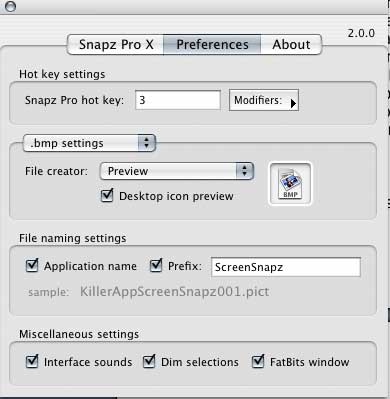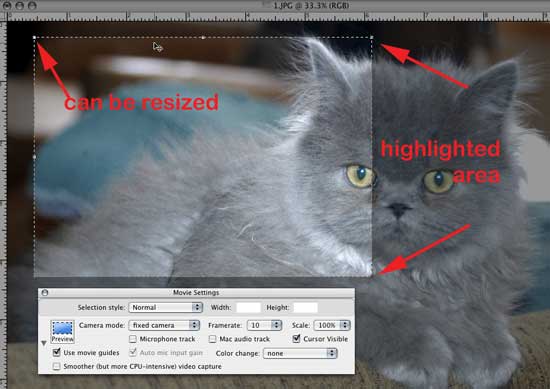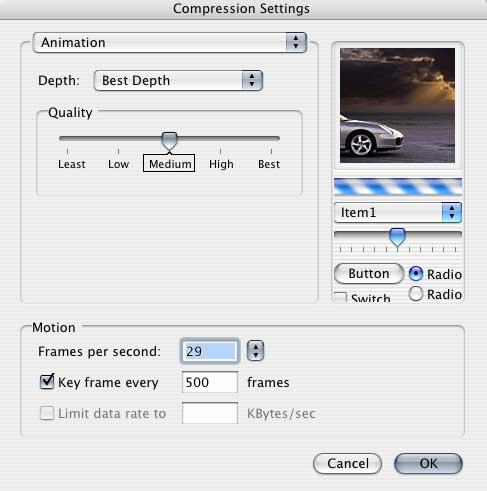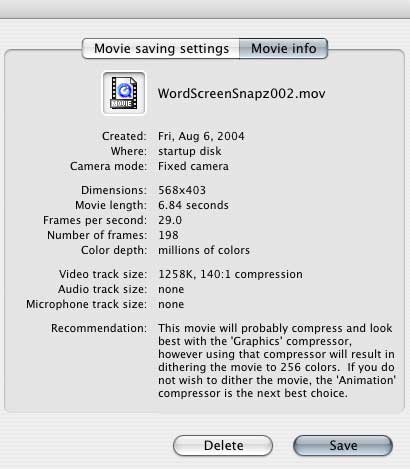Screen and/video captures can be an important
aspect of any production environment. Apple provides a limited
image capture tool incident to OS X, and there are shareware
screen capture utilities available on the Internet. SnapNDrag,
for instance, is a freeware screen capture utility more robust
than Apple's built-in keyboard sequence. (http://www.yellowmug.com/snapndrag/).
Others, such as Screen Catcher and ScreenRecord are available
for free or a small shareware cost. (http://graphicssoft.about.com/od/screencapturemac/).
Most provide good static screen grabs
for limited use. Recording screen movements in OS X is an entirely
different issue for those of us who produce tutorial CDs or DVDs
or have similar uses. In most cases, recording via a scan converter
has been the only, and pricey option. However, Ambrosia Software's
release of an OS X version of its classic SnapZ Pro capture tool
has changed the equation. Ambrosia claims that its movie capture
option is 20 times more powerful than others available. While
I couldn't independently verify the claim, I am impressed with
its capabilities, particularly on a fast DP G5. Mileage may vary
with less powerful OS X configurations.
This complete rewrite takes full advantage
of the power of OS X, adds new functionality to the OS9 version,
and provides an excellent alternative to expensive scan converters
when capturing full screen video even, in my case, a full
screen 30 fps capture of a Final Cut Pro session.
Installing the Snapz Pro X adds it to
your startup items, which has both an advantage and disadvantage.
First, the app will always be available with a preset or customized
hot key combination. The negative is that the app is always running
in the background, which could cause some concern for any video
production environment. However, the app utilizes virtually no
system resources, and did not provide any discernible interference
with any of my FCP or DVD SP sessions. If it still bothers you,
however, you can eliminate it as a startup option in your Accounts
pane, and then manually launch whenever you wish.
A second issue deals with an audio kernel
extension that permits you to capture your Mac's built in audio
output. I contacted Ambrosia to determine if this would interfere
with either Soundtrack or FCP, and was assured that it would
not. The only way it may cause a problem is if you have SP X
2 set to capture the Mac audio, which would mean no other application
would be able to grab the audio at the same time. This isn't
a likely case, however.
Launching SP X 2 produces the following
screen that controls captures of the screen, objects (menus,
etc), selections, and movies.

You can elect where the files are stored,
and how you name each file, or have it done automatically. The
preferences section includes settings to establish hot key launch
combination, file naming conventions, what application will launch
the captured file, and various settings for how SP X 2 interacts.
Make certain you turn off the "interface sounds." It
can get annoying.

Electing the "Movie Settings"
produces a number of options to control movie captures of your
Macintosh screen.

Once the Movie option selected, a highlighted
area of the screen appears.

The selection can be resized by grabbing
the sides or corners, and moved by clicking inside the highlighted
area and dragging the selection tool. You can also set the capture
target manually. There are drop down menus that control the aspect
ratio, size, frame rate, scale, and camera mode of the onscreen
movie capture. If you check the microphone box, SP X 2 records
your narration using an external or built in microphone. You
can capture any built in audio that your computer may be outputting.
There is another option to smooth video capture if you're not
getting the motion you require. The manual provides an extended
explanation of this option.
You may also set the movie capture to
follow your cursor, produce a "smooth pan" while following
the cursor, or to use a "fixed camera" to capture the
screen. Another option allows you to scale your capture from
10% to 400%.
Once captured, you can elect what video
codec you wish to output, and at what depth using the normal
QuickTime video save dialog box.

You can also view the move setting pertinent
to the movie you've just captured.

Various capture options have been expanded
for still screens as well, including the capability to grab single
and multiple menus. You can save in multiple formats including
bitmap, portable document format (PDF) and native Photoshop.
More accurate capture is possible using a magnification feature
with pixel-precise targeting, and a capture preview that dims
areas of the screen not being captured. This should eliminate
the need to clean up the images in Photoshop. You can capture
with various borders, elect square, rounded, or normal windows,
and capture with various fades and drop shadows.
There are literally dozens of settings
for each of the capture alternatives that govern final output.
Although SP X 2 is fairly intuitive to use, the supplied 54-page
PDF manual is fully illustrated with "getting started"
and detailed instructions on how to use the application. It discusses
the options and settings available for each type of capture and
suggested optimum settings depending on intended use.
If there is one negative to SP X 2, it's
that you cannot use it to capture its own images. To get some
of the screen grabs for this article, I resorted to Apple's utility.
Some may find all this functionality to be easily worth the price
of $69.95. With the newer movie capture capability, and the seamless
interfacing with OS X, I would have to agree. If you just do
occasional screen grabs, Apple's OS X utility or a shareware
app like SnapNDrag may be all you need. But for sheer breath
of capability and excellent movie capture, Snap Z Pro X with
movie capture is your best choice.
©Copyright 2004 David
Saraceno
All Rights Reserved
David
Saraceno is a motion graphics
artist located in Spokane, Washington. He has written for DV
Magazine, AV Video, MacHome Journal, and several state and national
legal technology magazines. David also moderates several forums
on 2-pop.com